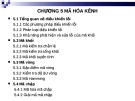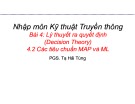
Introduction
1.1 OVERVIEW
Spheroidal wave functions are special functions in mathematical physics which
have found many important and practical applications in science and engineer-
ing where the prolate or the oblate spheroidal coordinate system is used. In
the evaluation of electromagnetic (EM) fields in spheroidal structures, spher-
oidal wave functions are frequently encountered, especially when boundary
value problems in spheroidal structures are solved using full-wave analysis.
By applying the separation of variables to the Maxwell’s equations satisfied
by either an electric or magnetic field, the spheroidal harmonics of electro-
magnetic waves, corresponding to their spheroidal coordinate system, can be
obtained.
With prolate or oblate spheroidal coordinates, the separation of scalar vari-
ables results in three independent functions: (1) the radial spheroidal function
R$$&,<) or &$ic, ic) , (2) the angular spheroidal function Smn(c, 7) or
Smn( -ic, q), and (3) the sine and cosine functions. This separability is anal-
ogous to that of solving the Laplace equation in spherical coordinates. Here
the last pair of trigonometrical functions (sine and cosine) is well known, but
the first two are not so easily computed. In general, spheroidal radial and an-
gular functions in spheroidal coordinates are, respectively, the generalization
of Legendre functions and spherical Bessel functions in the spherical polar
coordinates [6]. Computation of the spheroidal radial or angular functions
requires the eigenvalue computation and the forward and backward recur-
Spheroidal Wave Functions in Electromagnetic Theory
Le-Wei Li, Xiao-Kang Kang, Mook-Seng Leong
Copyright 2002 John Wiley & Sons, Inc.
ISBNs: 0-471-03170-4 (Hardback); 0-471-22157-0 (Electronic)

2
INTRODUCTION
sion formulations. Theoretically, the formulation of these harmonics was well
documented by J. A. Stratton et al. in 1956 [7] and C. Flammer in 1957 [l].
So far, there are only six coordinate systems in which the scalar Helmholtz
equations are separable and solenoidal solutions of the vector Helmholtz equa-
tions which are transverse to coordinate surfaces are obtainable: the rectan-
gular , the circular-cylinder, the elliptic-cylinder , the parabolic-cylinder, the
spherical, and the conical coordinate systems [S, 91. The prolate and oblate
spheroidal coordinate systems are two systems in which scalar wave equations
are separable but the vector wave functions are not separable because of the
nonorthogonality of spheroidal radial functions. This causes a difficulty in
obtaining rigorous solutions to those vector boundary value problems.
In computing EM or physical quantities, the nonorthogonality is involved
in the method of eigenfunctional expansions, in which the linear equations
in the form of nonorthogonal summation are converted to a matrix equation
system. The dimension of the matrix system is normally infinite and the con-
vergence depends mostly on the magnitudes of the interfocal distance and the
applied frequency range. The convergence also depends on the representation
of different kinds of spheroidal wave functions. Several kinds of spheroidal
vector wave functions have been introduced by researchers [lo-121. However,
most of them show fast convergence only for plane-wave scattering or far-field
approximations in free space. When the dielectric properties of propagation
media are lossy, the convergences of some kinds of spheroidal vector wave
functions become very slow. Furthermore, some kinds of spheroidal vector
wave functions converge much more slowly in the high-frequency region, al-
though it is possible to use these vector wave functions in the low-frequency
region.
When used to solve practical problems, the most appropriate spheroidal
vector wave functions are constructed by using the spheroidal scalar eigen-
functions as the generating function and the orthogonal coordinate vectors
(such as the unit vector in the rectangular coordinates) as the piloting vector
[13]. Construction of the spheroidal vector wave functions is similar to that
described by Tai [14] f or orthogonal coordinates (such as the rectangular or
spherical wave functions), except that the spheroidal vector wave functions
cannot simply be separated to those of transverse electric (TE) or transverse
magnetic (TM) modes. It is found in practical applications that this kind of
spheroidal vector wave function is very convenient in calculations involving in-
tegral equation expressions, especially for cases where the electric or magnetic
sources have arbitrary shapes.
One of the most convenient analytical methods of EM problems is the
integral representation of wave equations, in which the Green’s function is de-
sirable. To obtain electromagnetic radiation due to an arbitrary current dis-
tribution located in an inhomogeneous medium, the dyadic Green’s function
technique is usually adopted. If the source is of unknown current distribution,
the method of moments, which expands the current distribution into a series
of basis functions with unknown coefficients, can be employed. In this case,

OVERVIEW
3
the dyadic Green’s function is considered as a kernel of the integral. The
related unknown coefficients of the basis functions can be obtained in matrix
form by enforcing the boundary conditions to be satisfied. The construction
of Green’s dyadics in spheroidal structures using the appropriate spheroidal
scalar eigenfunctions is presented by Li et al. [15].
Theoretically, spheroidal structures can be reduced to spherical structures
when the interfocal distance d becomes zero or the radial coordinate becomes
infinity (while q = constant), as shown in Figs. 1.06 and 1.07 in [8]. For a
small-value parameter d, the spheroid can be well approximated by a sphere.
In comparing spherical and spheroidal functions, deviations from the spheri-
cal functions increases as d increases. It is clear that for a large d, spherical
approximation is not valid. Some analytical results of EM fields in spher-
oidal structures have been obtained using spherical vector harmonics [16,17];
however the convergences are generally slow and the results are less accurate
when the interfocal distances of spheroids become larger. Even in some cases
of spheroids with small d values, numerical results from the spherical approx-
imation are also not accurate for the near-field calculation or in the very high
frequency region. This is caused by the fact that more higher-order harmon-
ics are needed in the summation for near-field or high-frequency expressions.
The convergence condition of the spherical wave functions approximation in
such cases becomes worse than that of spheroidal eigenfunction expansions.
Besides the lack of orthogonality of spheroidal vector wave functions, the
very complicated calculation of the spheroidal angular and radial harmonics is
another difficulty in obtaining the analytical solutions in spheroidal structures
[1,5]. This is part of the reason that there have been many fewer reports about
the applications of spheroidal wave functions in computational electromagnet-
its than those related to other coordinate systems, although the spheroidal
wave functions have been known for more than 100 years. It is also found that
some of the previous computed results of spheroidal eigenvalues and spher-
oidal harmonics are not accurate [5], although they have been used elsewhere
for many years [ 1,181.
With the development of computer facilities and the appropriate method
and software routines for calculation (2,191, the numerical values tabulated
for spheroidal angular and radial functions can be obtained easily and accu-
rately. The analysis of spheroidal systems can be carried out in the same
way as in the spherical system, by using general integral equation expressions
with the formulated spheroidal Green’s functions and related spheroidal wave
functions, while the functional expansions should be employed in spheroidal
eigenfunction expansions. In practical programming, the spheroidal angular
and radial functions can be treated similarly to Legendre and Bessel functions
in spherical coordinates and obtained from available numerical tables or sub-
routine calling of specific packages. Prepared numerical tables are normally
preferred to the repetitive calculation of one spheroidal structure. Therefore,
many electromagnetic problems related to spheroidal structures can finally be

4 INTRODUCTION
solved directly in spheroidal wave function expansions by full-wave analysis
methods.
There have been an increasing number of applications of spheroidal wave
functions in computational electromagnetics. In antenna designs, rockets,
satellites, and guided missiles can be considered to have part of a spher-
oidal shape. The related EM wave scattering problems have been studied
for many years. In some applications, microstrip antennas are mounted on
curved spheroidal surfaces. With the development of mobile communications,
spheroidal dipoles and monopoles have been investigated intensively. Also,
electromagnetic interaction between the human head and a cellular antenna
and the health effects of mobile phone have been hot topics in recent years.
In these EM problems, the human head can be approximated as a dielectric
prolate spheroid. In the computation of the rainfall attenuation of microwave
signals, a raindrop can be modeled as an oblate spheroid, especially for rain-
drops of large sizes. In this book, we provide a generalized calculation and
discussion regarding the application of spheroidal wave functions in these EM
problems and attach our own developed software packages.
1.2 EM SCATTERING BY SPHEROIDS
EM waves scattered by a single spheroid or a system of n spheroids have been
well investigated, and many analytic solutions have been obtained to date.
Jen analyzed the field and current distribution of a prolate spheroidal dipole
antenna embedded in a larger dielectric confocal prolate spheroid with finite
conductivity [20]. He also gave a theoretically analyzed solution of the radia-
tion due to a thin linear monopole of arbitrary length erected at the tip and
along the axis of a metallic prolate spheroid of any length and eccentricity
[21]. Moffatt studied the echo area of a perfectly conducting prolate spheroid
[22,23]. The app roximate solution to the EM-wave backscattering from a pro-
late spheroid was obtained through modification of the impulse response or
time-dependent backscattering waveform from a perfectly conducting spheri-
cal scatterer.
Asano and Yamamato provided a solution of EM scattering by a homo-
geneous prolate (or oblate) spheroidal particle with an arbitrary size and
refractive index at any angle of incidence [24]. The method they used was
that of separating the vector wave equations in the spheroidal coordinates
and expanding them in terms of the spheroidal wave functions. The method
of determining the unknown coefficients for the expansion was similar to that
used in this book. However, Asano and Yamamato’s report only showed the
numerical results for c no larger than 10 (where c is the product of the wave
propagation constant and semi focal distance). Asano employed the same
method to determine that the prolate spheroids at parallel incidence have
steep and high resonance maxima in scattering efficiency factors, and broad
and low forward-scattering peaks in the intensity functions. On the other

SPHEROIDAL ANTENNA
5
hand, oblate spheroids at parallel incidence have broad and low resonance
maxima and sharp and high forward-scattering peaks [25]. It was shown that
at oblique incidence, the scattering properties of a long, slender prolate spher-
oid resemble those of an infinitely long circular cylinder [25].
Sinha and MacPhie also used spheroidal wave functions to characterize
scattering of plane waves with arbitrary polarization and angle of incidence
by conducting prolate spheroids [lo, 111. In their formulation, the column
matrix of the series coefficients of the scattered field is obtained from the
column matrix of the series coefficients of the incident field by means of a
matrix transformation. The matrix depends only on the scatterer, hence the
scattered field for a new direction of incidence is obtained without repeatedly
solving a new set of linear equations. This method was employed by some
other researchers and had many applications in physics and engineering.
Dalmas and Deleuil analyzed the multiple scattering of EM wave by two
infinitely conducting prolate spheroids, using the spheroidal vector wave func-
tions constructed along the radius vector [26]. The formulation which they
used requires the establishment of a translational addition theorem for the
wave functions of any translation [27]. Merchant et al. used Waterman’s
transition-matrix (T-matrix) method to obtain the complex pole patterns of
the scattering amplitude for conducting spheroids [28].
Cooray and Ciric presented their solutions of EM wave scattering by a
system of two perfectly conducting or dielectric spheroids of arbitrary orien-
tation 112,291. The method they used was similar to that of Sinha and Mac-
Phie [lo, 111. In order to impose the boundary conditions, the field scattering
by one spheroid is expressed in terms of the spheroidal coordinates attached
to the other spheroid, by using the rotational-translational addition theorem
for spheroidal vector wave functions [30]. The rotational-translational addi-
tion theorems were also verified recently by Nag and Sinha solving the EM
scattering by a system of two lossy dielectric prolate spheroids [31].
Using the same method as in [30], Cooray and Ciric solved the problems of
EM scattering by a system of n dielectric spheroids of arbitrary orientation [32]
and EM wave scattering by a coated dielectric spheroid [33]. Sebak and Sinha
provided the solution of a plane EM wave scattering by a conducting prolate
spheroid coated with a confocal homogeneous layer [34]. In their research,
the incident and scattered fields were expanded in terms of spheroidal vector
wave functions and the expansion coefficients for the scattered wave were
determined directly by the application of boundary conditions.
1.3
SPHEROIDAL ANTENNA
Interests in spheroidal wave functions and spheroidal antennas have come a
long way. Such an interest is understandable, as spheroidal antennas can be
used to model a variety of antenna shapes, from wire/cylindrical antennas via
spherical antennas to disk antennas (using oblate spheroid).













![Bộ tài liệu Đào tạo nhân viên chăm sóc khách hàng tại đơn vị phân phối và bán lẻ điện [Chuẩn nhất]](https://cdn.tailieu.vn/images/document/thumbnail/2025/20251001/kimphuong1001/135x160/3921759294552.jpg)


![Ngân hàng câu hỏi thi giữa kì môn Truyền động điện [Mới nhất]](https://cdn.tailieu.vn/images/document/thumbnail/2025/20250920/kimphuong1001/135x160/42601758354546.jpg)


![Câu hỏi ôn tập Quy trình an toàn điện có đáp án [kèm đáp án chi tiết]](https://cdn.tailieu.vn/images/document/thumbnail/2025/20250920/kimphuong1001/135x160/18761758354548.jpg)
![Đề thi trắc nghiệm Kỹ thuật mạch điện tử: Tổng hợp [Năm]](https://cdn.tailieu.vn/images/document/thumbnail/2025/20250920/kimphuong1001/135x160/23481758356189.jpg)


![Tài liệu ôn tập Thông tin quang [năm] [mới nhất]](https://cdn.tailieu.vn/images/document/thumbnail/2025/20250917/anvunguyen0207@gmail.com/135x160/56551758168054.jpg)


